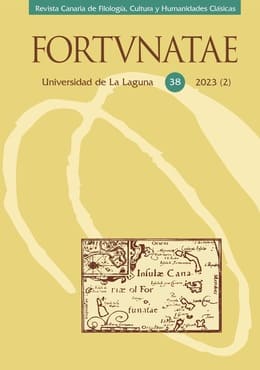El orden de las palabras como recurso poético en Tácito (Annales IV)
Resumen
En nuestro análisis de la obra deTácito, hemos explorado su estilo, en el que, entre otros aspectos, como la elipsis, destaca la alteración del orden de palabras en la frase como un rasgo significativo. Esta alteración, que contrasta con las estructuras habituales SOV y determinante-determinado», emerge como un recurso crucial en su prosa. Nuestro enfoque intenta demostrar que las dislocaciones afectan por igual al significado y al significante, y obedecen, por tanto, a motivaciones expresivas o estéticas. Además, consideramos el contexto de cambio lingüístico de su época y las preferencias de Tácito por modelos distintos, enriqueciendo la comprensión de su estilo y de su legado literario y conectando con la evolución hacia las lenguas neolatinas.
Citas
ADAMS, N. J. (1972): «The language of the later books of Tacitus’ Annals», The Classical Quarterly 22: 350-373. https://www.jstor.org/stable/638215.
ADAMS, N. J. (1976): «A typological approach to Latin word order», Indogermanische Forschungen 81: 70-99.
BAÑOS BAÑOS, J. M. - CABRILLANA LEAL, C. (2021): «El orden de palabras», en J. M. BAÑOS BAÑOS (coord. ed.), Sintaxis latina II, CSIC, Madrid, pp. 897-944.
BENARIO, H. (1975): An Introduction to Tacitus, University of Georgia, Athens.
BOETTICHER, W. (1830): Lexicon Taciteum sive de stilo C. Cornelii Taciti, Sumptibus G. C. Nauckii, Berolini.
COHEN, J. (1966): Structure du langage poétique, Editions du Seuil, Paris.
COHEN, J. (1970): «Théorie de la figure», Communications 16: 3-25.
DEVINE, A. M. - STEPHENS, L. D. (2006): Latin Word Order: Structured Meaning and Information, Oxford University Press.
DRAEGER, A. (1967): Syntax und Stil des Tacitus, Adolf Hakkert, Amsterdam.
FRIEDRICH, P. (1975): «Proto-Indo-European Syntax: The Order of Meaningful Elements», Journal of Indo-European Studies 1 (monografía), University of Chicago Press.
GOODYEAR, F. R. D. (2012): «Development of Language and Style in the Annals of Tacitus», en R. ASH (ed.), Tacitus, Oxford Readings in Classical Studies, Oxford, pp. 357-375 [first published in the Journal of Roman Studies 58, 1968, pp. 22-31].
GREENBERG, J. (1963): «Some universals of grammar with particular reference to the order of meaningful elements», en J. GREENBERG, Universals of Language, MIT Press, Cambridge, pp. 73-113.
HARRIS, Z. S. (1953): Methods in Structural Linguistics, Cambridge University Press, Cambridge.
HOCK, H.H. (2015): «Proto-Indo-European verb-finality: Reconstruction, typology, validation», en L. KULIKOV - N. LAVIDAS (eds.), Proto-Indo-European Syntax and its Development. John Benjamins, pp. 51-78.
HOFMANN, J. B. (1975): Lateinische Umgangssprache, Carl Winters Universitätsverlag, Heidelberg.
JAKOBSON, R. (1963): Essais de linguistique genérale, Minuit, Paris.
JAKOBSON, R. (1966): «Rapport entre langue émotionnelle et langue poétique», en Z. TODOROV (ed.), Théorie de la Littérature: Textes des formalistes russes, Editions du Seuil, Paris.
JEFFERS, R. - LEHISTE, I. (1979): Principles and Methods for Historical Linguistics, Massachusetts Institute of Technology, Cambridge.
LEHMANN, W. P. (1974): Proto-Indo-European Syntax, University of Texas Press, Austin. https://lrc.la.utexas.edu/books/pies/7-developments.
LÖFSTEDT, E. (1928): Syntactica: Studien und Beiträge zur Historischen Syntax des Latein, Gleerup, Lund.
LÖFSTEDT, E. (1948): «On the Style of Tacitus», The Journal of Roman Studies 38: 1-8. https://doi.org/10.2307/298162.
LÖFSTEDT, E. (1958): Roman Literary Portrait, Clarendon Press, Oxford.
MAROUZEAU, J. (1949): L’ordre des mots dans la phrase latine III, Les Belles Lettres, Paris.
MARTIN, R. H. (1969): «Tacitus and his Predecessors», en T. A. DOREY (ed.), Tacitus, Routledge, London, pp. 117-147.
MARTIN, R. H. (1981), Tacitus, Routledge, London.
MARTIN, R. H. (1971): Tacitus, Annales, lib. I, Methuen Educational Ltd., London.
MORENO CABRERA, J. C. (2000): Curso universitario de lingüística general. Tomo I: Teoría de la gramática y sintaxis general, Síntesis, Madrid.
OAKLEY, S. P. (2009): «Style and Language», en A. J. WOODMAN (ed.), The Cambridge Companion to Tacitus, Cambridge, pp. 195-211. https://doi.org/10.1017/CCOL9780521874601.015.
OWEN, M. - GILDENHARD, I. (2013): «Tacitus’ Style(as an Instrument ofThought)»,en Tacitus, Annals, 15.20-23, 33-45, Open Book Publishers, Cambridge, pp. 26-28. http://dx.doi.org/10.11647/OBP.0035.
PADILLA CARMONA, C. (2012): «Esboç d’una tipologia de l’oració complexa llatina», Studia Philologica Valentina 14: 109-124.
PINKSTER, H. (1995): Sintaxis y semántica del latín, (Trad. TORREGO - DE LA VILA), EdClas, Madrid.
PINKSTER, H. (2021): «Word Order», en H. PINKSTER, The Oxford Latin Syntax, vol. 2. The Complex Sentence and Discourse, Oxford University Press, pp. 948-1138.
QUINN, K. (1969): Latin Explorations, Routledge and Kegan Paul, London.
RUBIO, L. (1984): Introducción a la Sintaxis Estructural del Latín (1ª ed. 1966), Ariel, Barcelona.
SEGURA RAMOS, B. (1997): «Notas sobre el orden de palabras en latín», Faventia 19-2: 105-109.
SPEVAK, O. (2010): Constituent Order in Classical Latin Prose, Benjamins, Amsterdam / Philadelphia.
STUART, D. (1909): «Style ofTacitus»,en D. STUART (ed.),Tacitus: The Agricola, Macmillan, New York, pp. XIX-XXV. https://dcc.dickinson.edu/tacitus-agricola/stuart-intro/style-of-tacitus.
SYME, R. (1958): Tacitus (2 vols), Oxford University Press, Oxford. https://archive.org/details/symetacitus-1958-t.-1/mode/2up.
TOVAR, A. (1973): «Orden de palabras y tipología lingüística», Euphrosyne 9: 161-171.
VENNEMANN, A. (1974): «An Explanation of Drift», en N. L. CHARLES (ed.), Word Order and Word Order Change, University of Texas, Austin.
VOSSLER, K. (1954): Einfürung ins Vulgärlatien, Helmut Schmeck, München.
WALKER, B. (1952): The Annals of Tacitus, Manchester University Press, Manchester.
WOODMAN, A. J. (2021):«Language and Meaning inTacitus’ Annals», The Journal of Roman Studies 111: 215-224. https://www.cambridge.org/core/journals/journal-of-roman-studies/article/abs/language-and-meaning-in-tacitus-annals/44EC8286563CD9A900579718FB99188C.
WÖLFFLIN, H. (1867): «Tacitus (Jahresbericht)», Philologus 25: 92-134.

Esta obra está bajo licencia internacional Creative Commons Reconocimiento-NoComercial-SinObrasDerivadas 4.0.
Los autores conservan los derechos de autor y garantizan a la revista el derecho de ser la primera publicación del trabajo al igual que licenciarlo bajo una Creative Commons Attribution License que permite a otros compartir el trabajo con un reconocimiento de la autoría del trabajo y la publicación inicial en esta revista.
Los autores pueden establecer por separado acuerdos adicionales para la distribución no exclusiva de la versión de la obra publicada en la revista (por ejemplo, situarlo en un repositorio institucional o publicarlo en un libro), con un reconocimiento de su publicación inicial en esta revista.





